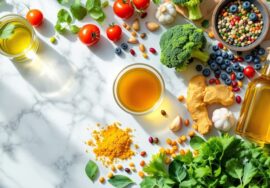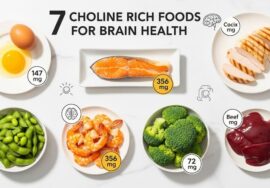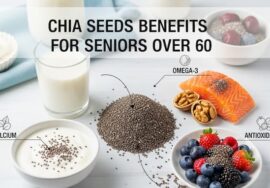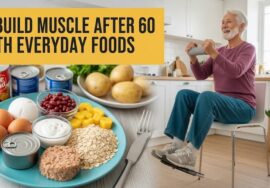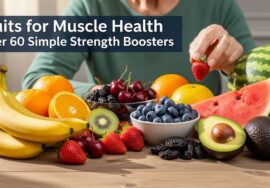Introduction: Why Circulation Matters in Older Age
Aging gracefully brings wisdom but also health challenges, and one often overlooked is circulation. Seniors may notice cold feet, tingling hands, or fatigue during short walks. These are signs that blood isn’t flowing as freely as it once did. Good circulation matters because it keeps oxygen and nutrients moving to muscles, the brain, and the heart.

With age, arteries stiffen and nitric oxide production drops, making blood vessels less flexible . While medication is sometimes essential, foods rich in natural compounds can help restore blood flow. John, 72, had stopped his park strolls until he learned that greens and beets could ease his leg heaviness. Small diet shifts can make a big difference.
Table of Contents
- Introduction: Why Circulation Matters in Older Age
- Leafy Greens That Support Healthy Blood Flow
- Superfoods That Strengthen Circulatory Health
- Easy Lifestyle Pairings to Maximize Benefits
- Q&A
- Final Thoughts
Leafy Greens That Support Healthy Blood Flow
Leafy greens such as spinach, kale, and collard greens are rich in dietary nitrates that convert into nitric oxide, helping arteries relax and blood flow more smoothly . In one Harvard study, seniors who ate a cup of greens daily had up to 26% lower heart disease risk .
- Spinach: Gentle nitrates support artery flexibility. Slip spinach into smoothies, omelets, or pasta. (Harvard Health shares nitrate insights here.)

- Kale: Packed with vitamin K and antioxidants, kale helps reduce stiffness in arteries. Mary, 73, swears her soups taste heartier with kale—and her fingers aren’t as cold on morning walks.

- Collard Greens: A Southern classic, collards provide magnesium to spark nitric oxide release, improving circulation and easing heavy legs.

These “gentle nitrate greens” don’t just lower blood pressure—they add fiber, minerals, and vibrant flavor to everyday meals.
Superfoods That Strengthen Circulatory Health
Beyond greens, several colorful foods and spices play a role in vascular health.
- Beets: Rich in nitrates, beets and beet juice widen blood vessels and boost oxygen delivery . In one trial, seniors drinking beet juice daily saw improved vessel function . Roast them for sweetness or grate into salads. Frank, 68, added beet smoothies to his week and noticed his uphill walks felt easier.

- Garlic: Known for centuries as a heart helper, garlic improves vessel dilation . In one study, garlic tablets boosted blood flow by 50% . Add it to soups, pasta sauces, or roast it for a milder flavor. Samuel, 74, laughed that “my pasta tastes better and my blood pressure is lower.”

- Berries & Pomegranate: These antioxidant-rich fruits protect vessel walls. Regular berry intake is tied to better artery flexibility , while pomegranate juice preserves nitric oxide . A handful of berries or a small glass of juice is enough.

- Turmeric & Ginger: Turmeric’s curcumin improves blood flow—one study saw a 37% increase after 12 weeks . Ginger consumption is linked with reduced blood pressure . Brew them in tea or stir into meals. Helen, 69, ends her day with ginger-turmeric tea, saying it warms her feet at night.

- Dark Chocolate: Cocoa flavanols stimulate nitric oxide, improving vessel function . A square of 70% dark chocolate is both a treat and a circulation booster.

These superfoods work best together—think spinach salad with berries, or roasted beets with garlic. They add variety and help the body produce nitric oxide naturally.
Easy Lifestyle Pairings to Maximize Benefits
Diet is powerful, but lifestyle makes the effect stronger:
- Post-meal walks: Even 10 minutes after lunch can raise nitric oxide release .
- Hydration & salt control: Water keeps blood moving, while cutting excess salt reduces swelling .
- Leg elevation: Resting with feet above hip level for 20 minutes helps veins drain .
- Citrus pairings: Lemon or orange juice boosts nitric oxide bioavailability and aids iron absorption from greens.
(See also Simple Natural Remedies for practical ideas.)
Q&A
Q1. Why is circulation vital for seniors?
It delivers oxygen and nutrients for energy, healing, and cognitive health .
Q2. Which leafy greens work best?
Spinach, kale, and collards—all nitrate-rich and vessel friendly .
Q3. How do nitrates help?
They convert into nitric oxide, which relaxes arteries .
Q4. What superfoods boost circulation?
Beets, garlic, berries, turmeric, ginger, and dark chocolate.
Q5. Can foods replace medication?
No, but they complement medical care. Always consult your doctor.
Q6. How often should these foods be eaten?
Aim for daily greens and beets or berries several times a week .
Q7. Are leafy greens safe with blood thinners?
Yes, but intake should stay consistent. Discuss with your provider.
Q8. Does exercise help alongside diet?
Yes, movement and circulation-friendly foods work best together .
Q9. I dislike salads—any alternatives?
Stir greens into soups, smoothies, or pasta sauces. Roast beets or add garlic to cooked dishes.
Q10. What signs suggest poor circulation?
Cold extremities, swelling, leg pain when walking, or slow-healing wounds.
Final Thoughts
Circulation is your body’s lifeline, and age doesn’t have to slow it down. By making spinach, kale, collards, beets, garlic, berries, and even a square of dark chocolate part of your meals, you help your arteries relax and your energy return. Pair those foods with walking, hydration, and leg elevation, and you’re stacking the odds in your favor.

